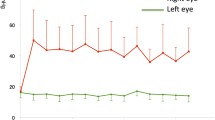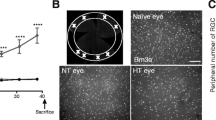Abstract
• Background: Current clinical tests do not detect glaucomatous signs until the onset of substantial retinal damage. Therefore animal models are required to investigate the very early histopathological alterations in glaucoma disease. We used an experimental model of intraocular hypertension to compare early changes in retinal ganglion cell (RGC) density with the thickness of the nerve fiber layer (NFL). • Methods: Methylcellulose 2% was injected into the anterior chamber of 18 eyes of 18 New Zealand albino rabbits. Intraocular pressure was measured 6 h after the injection and thence-forth once a day using a Shiötz tonometer. Histopathological analysis was performed on days 4, 10, and 15 following the induction of hypertension (six eyes for each group). Sections from the upper temporal retina were stained with hematoxylin-eosin and immunohistochemically using a polyclonal antibody PGP 9.5 to identify RGC. An image analysis system was used to evaluate the RGC and the thickness of the NFL.• Results: We observed a significant increase in intraocular pressure until the end of the experiment. Histological analysis showed, after 10 days of ocular hypertension, a significant decrease in RGC density (P<0.05) and a significant increase (P<0.05) in glial cell density. We found a significant correlation between RGC loss and cell area at 4 days (P<0.01; Cc=0.86) and at 10 days (P<0.002; Cc=0.91) of intraocular hypertension. We did not observe a significant decrease in the NFL thickness until 10 days of intraocular hypertension. • Conclusions: Our study confirms the size-dependent RGC loss during intraocular hypertension and shows no early decrease in NFL thickness.
Similar content being viewed by others
References
Airaksinen PJ, Heijl A (1983) Visual field and retinal NFL in early glaucoma after optic disc hemorrhage. Acta Ophthalmol 61: 186–194
Airaksinen PJ, Nieminen H (1985) Retinal NFL photography in glaucoma. Ophthalmology 92: 877–879
Airaksinen PJ, Drance SM, Douglas GR, et al (1985) Visual field and retinal NFL comparisons in glaucoma. Arch Ophthalmol 103: 205–207
Asai T, Katsumori N, Mizokami K (1987) RGC damage in human glaucoma. I. Studies on the somal diameter. Folia Ophthalmol Jpn 38: 701
Atkin A, Bodis-Wollner I, Wolkstein M, et al (1979) Abnormalities of central contrast sensitivity in glaucoma. Am J Ophthalmol 88: 205
Bonfanti L, Candeo P, Piccinini M, Carmignoto G, Comelli MC, Ghidella S, Bruno R, Gobetto A, Merighi A (1992) Distribution of protein gene product 9.5 (PGP 9.5) in the vertebrate retina: evidence that immunoreactivity is restricted to mammalian horizontal and ganglion cells. J Comp Neurol 322: 35–44
Caprioli J (1991) The contour of juxtapapillary nerve fiber layer in glaucoma. Ophthalmology 97: 358–366
Caprioli J, Miller JM (1989) Measurement of relative nerve fiber layer surface height in glaucoma. Ophthalmology 96: 633–641
Dandona L, Hendrickson A, Quigley HA (1991) Selective effects of experimental glaucoma on axonal transport by retinal ganglion cells to the dorsal lateral geniculate nucleus. Invest Ophthalmol Vis Sci 32: 1593–1599
Doran JF, Jackson P, Kynoch PAM, Thompson RJ (1983) Isolation of PGP 9.5, a new human neurone-specific protein detected by high-resolution two-dimensional electrophoresis. J Neurochem 40: 1542–1547
Drum B, Armaly M, Huppert W (1986) Scotopic sensitivity loss in glaucoma. Arch Ophthalmol 104: 712
Glovinsky Y, Quigley HA, Dunkelberger GR (1991) Retinal ganglion cell loss is size dependent in experimental glaucoma. Invest Ophthalmol Vis Sci 32: 484–491
Glovinsky Y, Quigley HA, Pease ME (1993) Foveal ganglion cell loss is size dependent in experimental glaucoma. Invest Ophthalmol Vis Sci 34: 395–400
Grehn F, Prost M (1983) Function of retinal nerve fiber depends on perfusion pressure: neurophysiologie investigation during intraocular pressure elevation. Invest Ophthalmol Vis Sci 24: 347–353
Hoyt WF, Newman NM (1972) The earliest observable defect in glaucoma? Lancet 1: 692–693
Quigley HA, Addicks EM, Green WR (1982) Optic nerve damage in human glaucoma. III. Quantitative correlation of nerve fiber loss and visual field defect in glaucoma, ischemic neuropa thy, disc edema, and toxic neuropathy. Arch Ophthalmol 100: 135
Quigley HA, Sanchez RM, Dunkelberger GR, L'Hernault NL, Baginski TA (1987) Chronic glaucoma selectively damages large optic nerve fibers. Invest Ophthalmol Vis Sci 28: 913
Quigley HA, Dunkelberger GR, Green WR (1988) Chronic human glaucoma causes selectively greater loss of large optic nerve fibers. Ophthalmology 95: 357
Quigley HA, Dunkelberger GR, Green WR (1989) Study of RGC atrophy correlated with automated perimetry in human eyes with glaucoma. Am J Ophthalmol 107: 453
Quigley HA, Katz J, Derick RJ, et al (1992) An evaluation of optic disc and nerve fiber layer examinations in monitoring progression of early glaucoma damage. Ophthalmology 99: 19–28
Sommer A, Miller NR, Pollack I, et al (1977) The nerve fiber layer in the diagnosis of glaucoma. Arch Ophthalmol 95: 2149–2156
Sommer A, Katz J, Quigley HA, et al (1991) Clinically detectable nerve fiber atrophy precedes the onset of glaucomatous field loss. Arch Ophthalmol 109: 77–83
Thompson RJ, Doran JF, Jackson P, Dhillon AP, Rode J (1983) PGP 9.5, a new marker for vertebrate neurons and neuroendocrine cells. Brain Res 278: 224–228
Tuulonen A, Lehtola J, Airaksinen PJ (1993) Nerve fiber layer defects with normal visual fields. Ophthalmology 100: 587–598
Tyler CW (1981) Specific deficits of flicker sensitivity in glaucoma and ocular hypertension. Invest Ophthalmol Vis Sci 20: 204
Wilkinson KD, Lee K, Deshpande S, Deurksen-Hughes, Boss JM, Pohl J (1989) The neuron-specific protein PGP 9.5 is a ubiquitin carboxyl-terminal hydrolase. Science 246: 670–673
Zhu MD, Cai FY (1992) Development of experimental chronic intraocular hypertension in the rabbit. Aust NZ J Ophthalmol 20: 225–234
Author information
Authors and Affiliations
Rights and permissions
About this article
Cite this article
Manni, G., Lambiase, A., Centofanti, M. et al. Histopathological evaluation of retinal damage during intraocular hypertension in rabbit: Involvement of ganglion cells and nerve fiber layer. Graefe's Arch Clin Exp Ophthalmol 234 (Suppl 1), S209–S213 (1996). https://doi.org/10.1007/BF02343074
Received:
Revised:
Accepted:
Issue Date:
DOI: https://doi.org/10.1007/BF02343074




